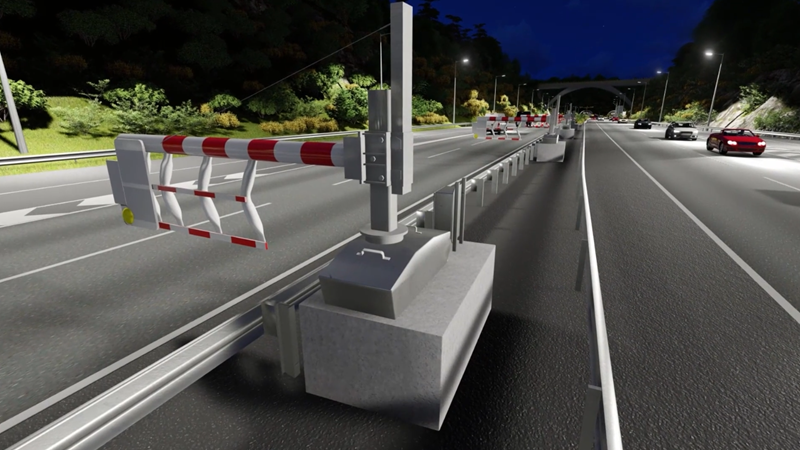Super swift gates can automatically close off lanes in minutes
Published
06 Jan 2022
We're trialling an automatic taper on our network which can quickly close lanes without putting road workers at risk

Share this article
The innovative SwiftGate can be fully deployed in around five minutes.
This is much quicker than the 25 minutes it takes road workers to put out cones directing fast-moving traffic away from a live lane.
We've teamed up with Kier and Highway Care to trial the automated taper gates on the north and southbound carriageways of the A3 Hindhead Tunnel in Surrey.
We regularly need to close the tunnel for essential maintenance work. To do this safely, workers cone off the entrances on the north and southbound carriageways.
In 2019, vehicles strayed into these roadworks on 14 occasions. Each incident put the lives of workers at risk.
The new gates clearly and safely filter traffic out of the lane. Workers can then put out cones beyond this taper, marking out the closure.
As well as keeping workers safe, the gates are a strong visual deterrent to drivers particularly at night-time.
"SwiftGate is another step to zero live lane working for our workforce as we work towards our goal of ensuring nobody is harmed while working or travelling on our roads"Martin Bolt, Head of Lean and Continuous Improvement, National Highways
Head of Lean and Continuous Improvement Martin Bolt, who has been overseeing the innovation for National Highways, said:
“Installing and removing a taper of cones in the face of traffic exposes our road workers to risk, particularly on elevated sections of road, bridges or tunnels where there may not be an embankment or place of safety.
“If successful, SwiftGate is another step to zero live lane working for our workforce as we work towards our goal of ensuring nobody is harmed while working or travelling on our roads.
“The automated tapers free up workers to do other jobs and can be put out in just 50 seconds meaning work can begin straight away with less disruption for road users. We look forward to seeing SwiftGate in action at Hindhead Tunnel.”
Kier Highways Senior Project Manager Mark Sheppard said:
“The SwiftGate project will give us a great opportunity to trial something that is completely new to the National Highways network, that will modernise the standard approach to road worker protection.
“Traffic management installation can be a high-risk activity, so the opportunity to introduce an automatic solution that has the potential to remove the need to put our workforce in the ‘firing-line’, is a worthy project.”
Highway Care Business Development Director Ben Duncker said:
“We are very pleased, after many months of hard work from the project team, that we are able to commence the trial of this exciting, safety innovation working collaboratively with Kier and National Highways.
“We are confident that the system will be a success in not only improving the safety of our traffic management operatives but also improving customer journeys through the faster and more efficient closing and reopening of lanes.
“Safety through innovation is our priority and the ability to trial such new solutions with National Highways is a testament to their commitment to making the roads safer for all users.”
SwiftGate follows successful trials of an automated cone laying machine by National Highways, Highway Care and Kier.
The Falcon ACLM vehicle puts out and retrieves cones, avoiding the need for a two-man team to lift and drop cones from the back of a moving vehicle.
A second automated cone laying machine, developed by King Highway Products through our innovation fund, is due to undergo further off-road testing shortly.
We have a ring-fenced pot, the Innovation and Modernisation Fund, which helps maximise the opportunities offered by technologies such as automated vehicles.
It is part of our Digital Roads 2025 vision which will fundamentally change how our roads are designed, built, operated and used. The strategy sets out how we will use the growth of digital technology and the move to electric, connected and autonomous vehicles to create the roads of the future.
